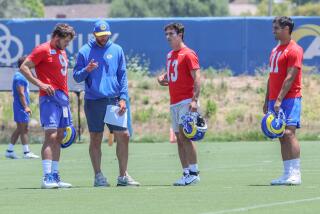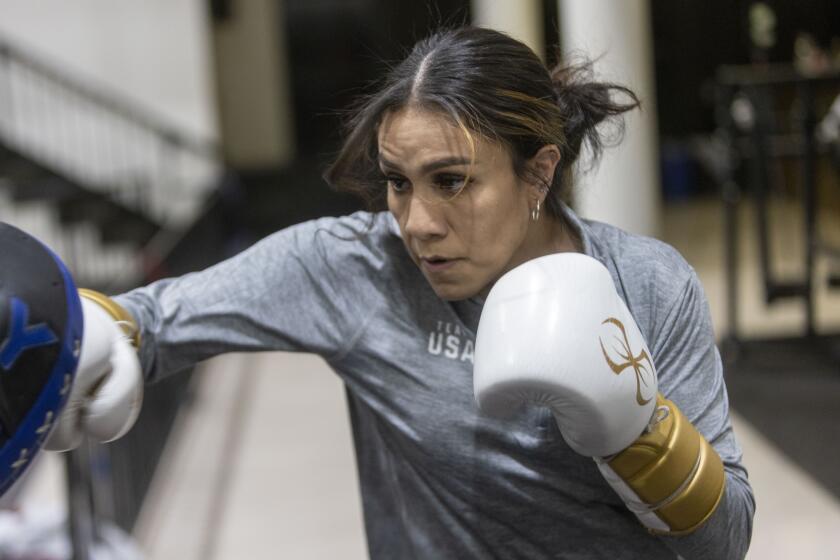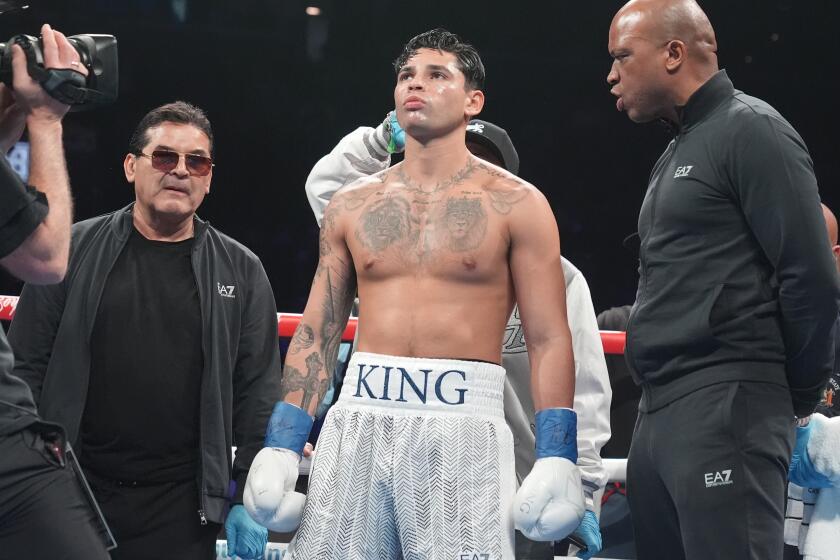Boxer Takes On New Fight: Reclaiming His Identity
Alex Ramos was a born fighter. By choice or by circumstance, inside the ring or out, he could be nothing else.
Reared in the blighted South Bronx, he escaped via the boxing ring. A four-time Golden Gloves winner, the middleweight contender swapped jabs with Michael Nunn and gibes with Howard Cosell. When he wound up in jail, an alcoholic and drug addict, Ramos fought on.
“I will die a boxer,” he once vowed.
Five years ago, his biggest fight seemed won. A newly sober Ramos had discovered his life’s purpose by starting a foundation to aid ex-fighters. Despair gave way to delight--until Ramos took a sucker punch from his past.
He was blindsided by Alberto Lugo.
Lugo, a childhood neighbor of Ramos, was inevitably among the triumphant crowd that filled Willis Avenue to greet its conquering hero whenever Ramos won a big fight. He was a hanger-on, a wannabe who longed for a taste of the boxer’s high life: the attention, the money, the women.
When he couldn’t make it happen, he simply made it up.
Across nearly two decades, in bars and casinos and parties, Lugo impersonated Ramos. Like a fighter donning his trunks and robe, he slipped easily into the skin of his old acquaintance.
“My name is Alex Ramos,” Lugo said over and over, parlaying his performance into fight tickets, hotel rooms and cash.
When Lugo was arrested for a 1983 rape, he used Ramos’ name. He did prison time under Ramos’ name. When he was released four years ago, he remained a pretender.
In February 1999, Lugo was arrested again, this time for drugging and sexually assaulting women. They had found their man, he told the police. Yes, he was Alex Ramos. The boxer.
The real Ramos, reborn and living in California, had one more battle to wage--the fight to reclaim his name.
*
Ramos was born in January 1961, two months after the Lugos welcomed their son, Alberto. When the Ramos family moved from Manhattan to the South Bronx, the two families became neighbors.
Their sons crossed paths on the playground behind P.S. 40, where Alex’s mother taught and the local kids hung out.
“He was not one of my boys,” Ramos says now of Lugo. “I’ve said hello to him, even shaken his hand. But he was never a friend.”
Ramos was the son of a fighter. At age 11, the 90-pound kid followed his old man into the ring, punching his way to four local Golden Gloves titles and a spot on the national amateur boxing team.
“Every time Howard Cosell did my fights,” he recalls proudly, “I won by first-round knockout.”
Ramos’ shot at the 1980 U.S. Olympic team was lost in America’s boycott of the Moscow Games. Undaunted, the 19-year-old turned pro in late 1980, knocking out his first two opponents within 16 days.
“He had the potential to go far,” remembers Jose Torres, the ex-light-heavyweight champ. “He was a good puncher--oh, yeah.”
The neighborhood followed Ramos intently. A sign on a local candy shop proclaimed, “Ramos--The East 136th Street Champ.” His loose-knit South Bronx fan club included Lugo, dubbed “Spooky” for the vacant look that sometimes crossed his face.
By November 1981, Ramos’ record stood at 12-0 with seven knockouts. An August 1982 eighth-round KO loss put a crimp in his title-shot plans, but an undeterred Ramos moved to Scottsdale, Ariz., and began working with Sugar Ray Leonard’s trainer, Janks Morton.
Back in New York, Lugo was discovering that five words--”My name is Alex Ramos”--could catapult him from obscurity to instant celebrity.
Over the last decade, several athletes have been victimized by impersonators: football stars Lawrence Taylor and Charles Mann, basketball’s Dee Brown, former boxing champion Freddy “Red” Cochran.
“If you’re going to impersonate someone, you’re going to pick something with glamour,” says Richard Lapchick, head of the Center for the Study of Sport in Society. “Athletes, with the amount of money they command and the star power--perfect.”
In 1983, as Ramos did roadwork in Arizona, Lugo was on the prowl in Manhattan. He was charming, articulate, charismatic. He was, as he told everyone, Alex Ramos.
One evening, the phone in Scottsdale rang. A Manhattan rape victim had told detectives that she was attacked by the boxer, Alex Ramos.
Ramos had an alibi, and police had a suspect. The fighter flew back to his hometown, where police showed him an array of pictures.
“I knew only one guy,” Ramos recalls. “I knew Spooky.”
Lugo, convicted in 1985, began a 3-to-9-year prison stretch on Jan. 8, 1986. Throughout, Lugo insisted that he was Ramos. Nobody ever corrected him. State corrections officials still list him under a combination of his birth and bogus names: “Ramos, Alberto.”
The real Ramos, struggling with his career and his own demons, put the bizarre impersonation behind him when Lugo was incarcerated. Ramos relocated to California, where his life in and out of the ring quickly crumbled.
In 1984 he earned the U.S. Boxing Assn. middleweight crown, but he lost it the next year, taking a vicious beating.
Cocaine and booze became a devastating one-two that Ramos couldn’t slip. He blew through an estimated $500,000 in earnings and spent too much time chasing women, too little time in the gym.
A 1986 title shot ended with a loss to future two-time champion Michael Nunn, and the big-money fights disappeared. Two years later, Ramos received word that his mother was dying back in the Bronx. He needed money for a flight home. There was none, his managers said.
Ramos was broke.
Stranded in California, he waited helplessly as his mother died. Drunk and enraged, he accused his managers--rightly, he still says--of stealing a $54,000 purse and brutally beat them.
Ramos was convicted of assault with a deadly weapon--his fists--and spent 22 months in prison. After his release in 1990, he returned to the ring. He also returned to cocaine, and then to prison on a 1993 parole violation.
A year later, released and reinvigorated, Ramos won nine straight fights before heading to Argentina for a $25,000 payday and a WBA title shot against Jorge Castro. He was knocked out in the second round in what became his last professional fight.
His lifetime record was 39-10-2, with 24 KOs.
After retiring, Ramos awoke one morning “in a sweat and in tears” after a nightmare that he had died penniless, like the great heavyweight Joe Louis.
It was 1995, and Ramos spent the next six months in a free Santa Monica rehabilitation clinic. Now clean, the ex-pug decided to give something back to the fight game: he helped create the Retired Boxers Foundation.
The nonprofit organization lends a hand to needy ex-fighters--those battling drug and alcohol woes, those left penniless or homeless, those who just took too many shots to the head.
Through this work, he reclaimed his prominent position in the boxing community. Flashing a wide smile and raising a boxer’s fist, he posed for pictures with referee Mills Lane, ex-heavyweight contender Gerry Cooney, Olympic boxing champion Mark Breland.
But as Ramos rebuilt his life, Lugo was resurrecting his own version of the Ramos saga.
*
After doing his time on the rape conviction, Lugo was released on Christmas Eve 1989. But he couldn’t avoid trouble. City and state records show he was jailed repeatedly for violating parole and probation, including once for selling drugs.
On Sept. 13, 1996, he was released after three months behind bars on his latest violation and moved into an apartment near the Hudson River in Manhattan. He was single, childless and ready to party.
Lugo took to the town as Ramos yet again.
“He held himself out to be Alex Ramos on a daily basis,” acknowledged Lugo’s latest attorney, Kyle Watters.
One night Lugo arrived for dinner at a friend’s home and introduced himself to one and all as the boxer, a happy spiel that infuriated one guest.
Her name was Miriam Martinez, and she was Ramos’ sister. She confronted Lugo, and he left.
Other nights, Lugo headed to the bars of the Lower East Side. There, buying drinks and holding court for the ladies, he was again Ramos. He was in training for a title shot, he boasted.
Lugo found a number of women quite willing to say yes to a successful athlete’s sexual overtures, his lawyers said. For those who said no, Lugo used another technique, authorities charged.
On Sept. 15, 1998, he lured a 19-year-old woman to a Manhattan hotel room with a promise of a job as a ring-card girl. As she sipped her drink, she collapsed, and he tried to rape her, the woman told police.
On Feb. 11, 1999, a 26-year-old woman visiting from Atlanta met Lugo at a bar. He bought her a beer, insisting she drink it. When she woke up later, she was naked from the waist down and knew she had been raped, she told police.
There was a third incident, although Lugo later insisted all three involved consensual sex. Authorities disagreed. Lugo, still identifying himself as Ramos, was arrested in February 1999 for rape, kidnapping and sodomy.
The two detectives who arrested him bought his act. They asked for an autograph.
Word spread around New York in the weeks before the March 13, 1999, Madison Square Garden title fight between Lennox Lewis and Evander Holyfield: Alex Ramos was a rapist.
But it was Lugo sitting in Rikers Island in lieu of $250,000 bond, even if no one knew him by that name. In court papers, in an NYPD press release, in conversations with his lawyer, he remained Alex Ramos.
*
In California, Ramos took a call from his panicked father about the rape case. Ramos’ reputation, and his fledgling foundation, had suffered a major hit.
“A large donor called from New York and said they would not contribute to any foundation with a rapist,”’ Ramos recalls.
The first time around, Ramos had shrugged off Lugo’s identity swapping. Not this time.
“I felt it was the last fight of my life,” Ramos says.
In August, Ramos sat in the witness chair at Lugo’s Manhattan rape trial and stared down his onetime fan.
“He would not look at me,” Ramos says. “My eyes were burning holes in his soul, in his heart.”
Defense attorney Jose Muniz noticed a slight resemblance between the pair: “A little bit, not striking.” Ramos’ chin was more chiseled, his eyes brighter, his hair a little grayer.
Assistant District Attorney Martha Bashford, who had called Ramos to testify, began her questions.
No, Ramos said, he never committed the crimes charged against Lugo.
No, he had never given permission for Lugo to use his name.
Lugo didn’t testify, but Bashford played a videotaped interview with him in which he insisted he was Ramos.
“I boxed for a while,” he boasted.
“Amateur? Professional?” Bashford asked.
“Both,” he replied.
The Manhattan jury convicted him in five hours. Lugo seemed surprised by the verdict, squinting at the jurors as each conviction was read.
Then he leaned over toward Muniz.
“Jose,” he asked, “how could they find me guilty?”
Muniz offered a one-word answer: “Credibility.”
Sentenced Sept. 12 to 148 years in prison, Lugo has hired a new lawyer and plans an appeal that he will watch from behind bars.
For Alex Ramos, his good name is once again his. If Lugo ever abuses it again, Ramos vows, there will be one last brawl.
“Put me in a room with this guy, and I’ll tell you for a fact--I’m the only one coming out of that room,” Ramos says, his voice hard. “You’ll know who the real Alex Ramos is.”
*
Retired Boxers Foundation, https://www.globalaffairs.com/rbf/
More to Read
Go beyond the scoreboard
Get the latest on L.A.'s teams in the daily Sports Report newsletter.
You may occasionally receive promotional content from the Los Angeles Times.






